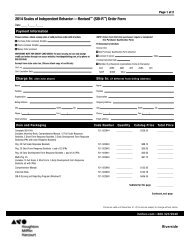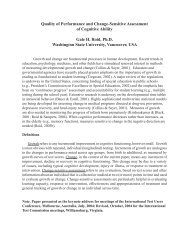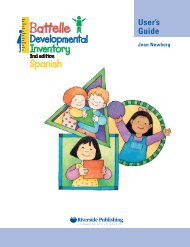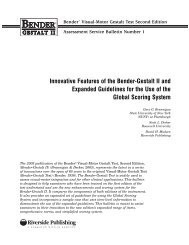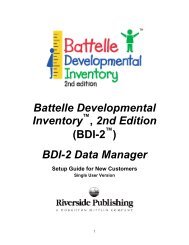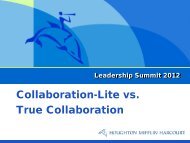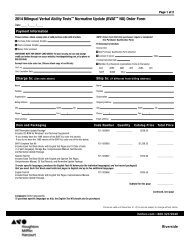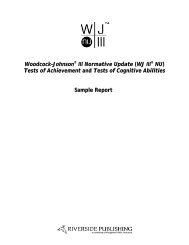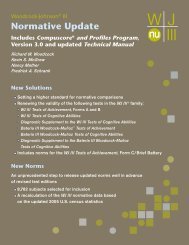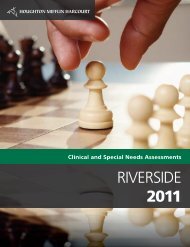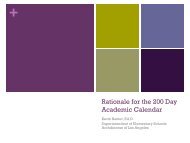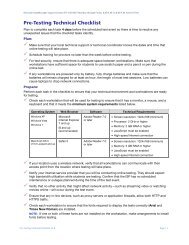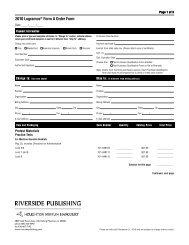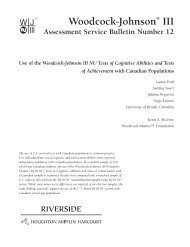Woodcock- Johnson III Tests of Cognitive Abilities - Riverside ...
Woodcock- Johnson III Tests of Cognitive Abilities - Riverside ...
Woodcock- Johnson III Tests of Cognitive Abilities - Riverside ...
Create successful ePaper yourself
Turn your PDF publications into a flip-book with our unique Google optimized e-Paper software.
processes required for academic performance in the affected domain, and instructionalinterventions is not as widely understood. As the focus <strong>of</strong> pr<strong>of</strong>essional practice shiftsfrom determining service eligibility to assessing basic psychological processes that informappropriate instruction, a need exists for providing a link between cognitive assessmentand evidence-based educational interventions. Research has shown that the CHC broadand narrow abilities differentially predict performance on academic tasks (Evans, et al.,2002; Floyd, et al., 2003; Floyd, et al., 2008). This bulletin describes some differentialimplications for planning appropriate interventions and/or selection <strong>of</strong> accommodationsbased on an assessment <strong>of</strong> the CHC broad and narrow abilities as identified by the WJ <strong>III</strong>COG and DS.The purpose <strong>of</strong> this bulletin is to describe how information gleaned from performanceon the WJ <strong>III</strong> COG and DS can be useful for developing instructional interventions oraccommodations, particularly when limited pr<strong>of</strong>iciency is identified in a broad or narrowability and/or associated with a specific cognitive process. To provide an organizationalschema that relates WJ <strong>III</strong> COG and DS test performance to evidence-based interventions,this bulletin outlines the broad factors and narrow abilities defined by CHC theory andprovides brief descriptions <strong>of</strong> the cognitive processes required for performance in each<strong>of</strong> the tests. Suggested interventions or accommodations that are conceptually relatedto the narrow abilities and cognitive processes are included (see Table 1). As examples,some interventions are described in this bulletin. References to research evidence for eachsuggested intervention are provided for further information.Table 1.Organizational Schema Relating WJ <strong>III</strong> COG and Diagnostic Supplement <strong>Tests</strong>,CHC Broad Factors and Narrow <strong>Abilities</strong>, <strong>Cognitive</strong> Processes, andRelated Educational InterventionsTestTest 1: Verbal Comprehension Comprehension-Knowledge (Gc )Lexical knowledgeLanguage developmentTest 2: Visual-AuditoryLearningPrimary Broad CHC FactorsNarrow CHC <strong>Abilities</strong> <strong>Cognitive</strong> Process(es) Related Educational InterventionsLong-Term Retrieval (Glr )Associative memoryTest 3: Spatial Relations Visual-Spatial Thinking (Gv )VisualizationSpatial relationsTest 4: Sound Blending Auditory Processing (Ga )Phonetic codingObject recognition andreidentification; semanticactivation, access, andmatching; verbal analogicalreasoningPaired-associative encodingvia directed spotlightattention; storage andretrievalVisual feature detection;manipulation <strong>of</strong> visualimages in space; matchingSynthesis <strong>of</strong> acoustic,phonological elementsin immediate awareness;matching the sequence <strong>of</strong>elements to stored lexicalentries; lexical activation andaccessCreating a vocabulary-rich learningenvironment, particularly reading aloud toa young child and discussing new words;text talks; directed vocabulary thinkingactivities; explicit teaching <strong>of</strong> specific words;semantic feature analysis; semantic maps;use <strong>of</strong> computer technology to develop wordknowledge; association <strong>of</strong> key words to priorknowledge; reading for a variety <strong>of</strong> purposes;independent word-learning strategiesActive, successful learning experiences;rehearsal; overlearning; organizationalstrategies; mnemonics; illustrate or visualizecontentMultisensory teaching techniques; privatespeechEarly exposure to language sounds; promotingphonological awareness; direct instruction insound blending; practice blending sounds intowords



